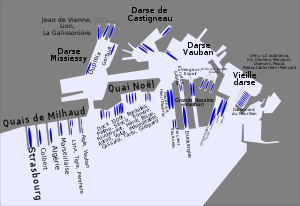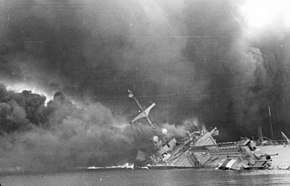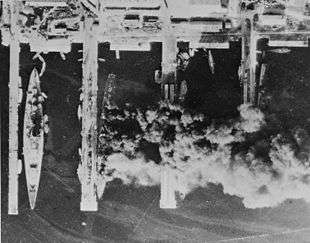Scuttling of the French fleet at Toulon
The scuttling of the French fleet at Toulon was orchestrated by Vichy France on 27 November 1942 to prevent Nazi German forces from taking it over. The Allied invasion of North Africa had provoked the Germans into invading the zone libre, neutral according to the Armistice of 1940. The Vichy Secretary of the Navy, Admiral François Darlan, defected to the Allies, who were gaining increasing support from servicemen and civilians. His replacement, Admiral Gabriel Auphan, guessed correctly that the Germans were aiming to seize the large fleet at Toulon, and ordered them to be scuttled.
The Germans began Operation Anton but the French naval crews used deceit to delay them until the scuttling was complete. Anton was judged a failure, with the capture of 39 small ships, while the French destroyed 77 vessels; several submarines escaped to French North Africa. It marked the end of Vichy France as a credible naval power.
Context
After the Fall of France and the Armistice of 22 June 1940, France was divided in two zones, one occupied by the Germans, and the Zone libre (Free Zone). Officially, both zones were administered by the Vichy regime. The armistice stipulated that the French fleet would be largely disarmed and confined to its harbours, under French control. The Allies were concerned that the fleet, which included some of the most advanced warships of the time, might fall into German hands and the British attacked the French Fleet at Mers-el-Kebir on 3 July 1940 and at the Battle of Dakar on 23 September 1940.
On 8 November 1942 the Allies invaded French North Africa in Operation Torch. It may be that General Dwight Eisenhower, with the support of President of the United States Franklin D. Roosevelt and British Prime Minister Winston Churchill, made a secret agreement with Admiral François Darlan, commander of Vichy Naval forces, that he would be given control of French North Africa if he defected to the Allies. An alternative view is that Darlan was an opportunist and switched sides for self-advancement, thus becoming titular controller of French North Africa. Following the Allied invasion of French North Africa, Adolf Hitler ordered Case Anton, the occupation of Vichy France and reinforced German forces in Africa.
Prelude
Political aspect
From 11 November 1942 negotiations took place between Germany and Vichy France. The settlement was that Toulon should remain a "stronghold" under Vichy control and defended against the Allies and "French enemies of the government of the Marechal". Grand Admiral Erich Raeder, commander of the Kriegsmarine, believed that French Navy officers would fulfil their armistice duty not to let the ships fall in the hands of a foreign nation.
Raeder was led to believe that the German aim was to use anti-British sentiment amongst the French sailors to have them side with the Italians, while Hitler was really preparing to seize the fleet. Hitler's plan was to have German sailors capture the French ships and turn them over to Italy; German officers privy to this plan were critical but their objections were ignored. Orders to implement the plan were given on 19 November.
On 11 November, as German and Italian troops encircled Toulon, the Vichy Secretary of the Navy, Admiral Gabriel Auphan, ordered Admirals Jean de Laborde and André Marquis to:
- Oppose, without spilling of blood, the entry of foreign troops in any of the establishments, airbases and buildings of the Navy
- Similarly oppose entry of foreign troops aboard ships of the Fleet and find settlements by means of local negotiation
- If the former proved impossible, to scuttle the ships
Initial orders were to scuttle the ships by capsizing them but engineers, thinking of recovering the ships after the war, managed to have the orders changed to sinking on an even keel. On 15 November, Laborde met with Marshal Philippe Pétain and Auphan. In private, Auphan tried to persuade Laborde to set sail and join with the Allies; Laborde refused to obey anything short of a formal order of the government and Auphan resigned shortly after.
Technical and tactical aspect

On the French side, as a token of goodwill towards the Germans, coastal defences were strengthened to safeguard Toulon from an attack from the sea by the Allies. These preparations included preparations for scuttling the fleet, in case a landing attempt by the Allies succeeded. French forces were commanded by Admiral Jean de Laborde (chief of the "High sea fleet", composed of the 38 most modern and powerful warships) and Admiral André Marquis (préfet maritime, commanding a total of 135 ships, either in armistice custody or under repair).
Under the armistice, French ships were supposed to have their fuel tanks almost empty; in fact, through falsification of reports and tampering with gauges, the crews had managed to store enough fuel to reach North Africa. One of the cruisers, Jean de Vienne, was in drydock, helpless. After the remnants of the French Army were required by the Germans to disband, French sailors had to man coast defence artillery and anti-aircraft gun themselves, which made it impossible swiftly to gather the crews and have the ships quickly under way.
Crews were initially hostile to the Allied invasion but out of the general anti-German sentiment and as rumours about Darlan's defection circulated, this stance evolved towards backing De Gaulle. The crews of Strasbourg, Colbert, Foch and Kersaint, notably, started chanting "Long live De Gaulle! Set sail!" In the afternoon of 12 November, Admiral Darlan further escalated the tension by calling for the fleet to defect and join the Allies.
Vichy military authorities lived in fear of a coup de main organised by the British or by the Free French. The population of Toulon was in the main favourable to the Allies; the soldiers and officers were hostile to the Italians, seen as "illegitimate victors" and duplicitous, and defiant of the Germans. The fate of the fleet, in particular, was seen to be doubtful. Between the 11th and the 26th, numerous arrests and expulsions took place. The French admirals, Laborde and Marquis, ordered their subordinates to take a pledge of allegiance to the regime (two of the senior officers, Humbertand and capitaine de vaisseau Pothuau, refused). The crews were first kept aboard their ships, and when they were allowed ashore the Service d'ordre légionnaire monitored all places suspected to be targeted by the Resistance.
Operation Lila
The objective of Operation Lila was to capture the units of the French fleet at Toulon intact, and was carried out by the 7th Panzer Division, augmented with units from other divisions. Four combat groups including two armoured groups and a motorcycle battalion from 2nd SS Panzer Division Das Reich were entrusted with the mission. To prevent the French naval units scuttling themselves, Marinedetachment Gumprich was assigned to one of the groups.[2]
The Operation was initiated by the Germans on 19 November 1942, to be completed by 27 November. German forces were to enter Toulon from the east, capturing Fort Lamalgue, headquarters of Admiral Marquis and Mourillon arsenal; and from the west, capturing the main arsenal and the coastal defenses. German naval forces were cruising off the harbor to engage any ships attempting to flee, and laid naval mines.
The combat groups entered Toulon at 4 a.m. on 27 November and made for the harbour, meeting only weak and sporadic resistance. At 4 a.m. the Germans entered Fort Lamalgue and arrested Marquis, but failed to prevent his chief-of-staff, Contre-Admiral Robin, from calling the chief of the arsenal, Contre-Admiral Dornon. The attack came as a complete surprise to the Vichy officers, but Dornon transmitted the order to scuttle the fleet to Admiral Laborde aboard the flagship Strasbourg. Laborde was taken aback by the German operation, but transmitted orders to prepare for scuttling, and to fire on any unauthorised personnel approaching the ships.
Twenty minutes later, German troops entered the arsenal and started machine-gunning the French submarines. Some of the submarines set sail to scuttle in deeper water. Casabianca left her moorings, snuck out of the harbour and dove at 5:40 a.m., escaping to Algiers. The German main force got lost in the arsenal and was behind schedule by one hour; when they reached the main gates of the base, the sentries pretended to need paperwork so as to delay the Germans without engaging in an open fight. At 5:25 a.m., German tanks finally rolled through, and Strasbourg immediately transmitted the order "Scuttle! Scuttle! Scuttle!" by radio, visual signals and dispatch boat. French crews evacuated, and scuttling parties started preparing demolition charges and opening sea valves on the ships.

At 6:45 a.m. fighting broke out around Strasbourg and Foch, killing a French officer and wounding five sailors. When naval guns started engaging the German tanks, the Germans attempted to negotiate; a German officer demanded that Laborde surrender his ship, to which the admiral answered that the ship was already sunk.
As Strasbourg settled on the bottom, her captain ordered the ignition of the demolition charges, which destroyed the armament and vital machinery, as well as igniting her fuel stores. Strasbourg was a total loss. A few minutes later the cruiser Colbert exploded. The German party attempting to board the cruiser Algérie heard the explosions and tried to persuade her crew that scuttling was forbidden under the armistice provisions. However, the demolition charges were detonated, and the ship burned for twenty days.
Meanwhile, the captain of the cruiser Marseillaise ordered his ship capsized and demolition charges set. German troops requested permission to come aboard; when this was denied, they did not attempt to board. The ship sank and exploded, burning for seven days.
German troops forcibly boarded the cruiser Dupleix, put her crew out of the way, and closed her open sea valves. The ship's captain, Moreau, ordered the scuttling charges in the main turrets to be lit with shortened fuses and when they exploded and fires took hold, Moreau ordered the final evacuation. French and Germans alike fled the vessel. Explosions from the ship's torpedo stores destroyed the vessel, which burned for ten days.

The cruiser Jean de Vienne, in drydock, was boarded by German troops, who disarmed the demolition charges, but the open sea valves flooded the ship. She sank, blocking the drydock. In another drydock, the captain of the damaged Dunkerque, which had been heavily damaged by the British in the attack on Mers-el-Kébir, at first refused orders to scuttle, but was persuaded by his colleague in the nearby cruiser La Galissonnière to follow suit. The crew opened the holes caused by British torpedo attacks to sink the ship, and demolition charges destroyed her vital machinery. As Dunkerque exploded, La Galissonnière reproduced the manoeuvre executed by Jean de Vienne.
Officers of the battleship Provence and the seaplane carrier Commandant Teste managed to delay German officers with small talk until their ships were completely sunk.
Similar scenes occurred with the destroyers and submarines. The Germans eventually seized three disarmed destroyers, four badly damaged submarines, three civilian ships, and the remains of two battleships of no value, the semi-dreadnought Condorcet and the disarmed former Jean Bart, renamed Océan in 1936.
Aftermath

Operation Lila was a failure. The French destroyed 77 vessels, including 3 battleships, 7 cruisers, 15 destroyers, 13 torpedo boats, 6 sloops, 12 submarines, 9 patrol boats, 19 auxiliary ships, 1 school ship, 28 tugs, and 4 cranes. Thirty-nine small ships were captured, most of them sabotaged and disarmed. Some of the major ships were ablaze for several days, and oil polluted the harbour so badly that it would not be possible to swim there for two years.
Several submarines ignored orders to scuttle and chose to defect to French North Africa: Casabianca and Marsouin reached Algiers, Glorieux reached Oran. Iris reached Barcelona. Vénus was scuttled in the entrance of Toulon harbour. One surface ship, Leonor Fresnel, managed to escape and reach Algiers.
General Charles de Gaulle heavily criticised the Vichy admirals for not ordering the fleet to flee to Algiers. The Vichy regime lost its last token of power, as well as its credibility with the Germans, with the fleet. While the German Naval War Staff were disappointed, Adolf Hitler considered that the elimination of the French fleet sealed the success of Case Anton.[2]
Most of the light cruisers were salvaged by the Italians, either to restore them as fighting ships or for scrap. The cruisers Jean de Vienne and La Galissonnière were renamed FR11 and FR12, respectively, but their repair was prevented by Allied bombing and their use would have been unlikely, given the Italians' chronic shortage of fuel. Even the light destroyer Le Hardi (renamed FR37) and another four of the same class as Le Hardi were salvaged: FR32 (ex-Corsaire), FR33 (ex-Epée), FR34 (ex-Lansquenet), FR35 (ex-Fleuret).
The main guns from the scuttled battleship Provence were later removed and used in a former French turret battery at Saint-Mandrier-sur-Mer, guarding the approaches to Toulon, to replace original fortress guns, sabotaged by their French crews. Mounting four 340 mm (13 in) guns, in 1944 this fortification duelled with numerous Allied battleships for over a week before being silenced during Operation Dragoon.[3]
Ships sunk
|
Battleships
Seaplane tender Sloops
|
Destroyers
|
Heavy cruisers Torpedo-boats
|
Light cruisers Submarines
|
See also
- Attack on Mers-el-Kébir, a British attempt to destroy the French fleet
- Scuttling of the Peruvian fleet at El Callao, during the War of the Pacific
- Scuttling of the German fleet at Scapa Flow, a similar incident involving the German fleet after World War I
Notes and references
- Position des bâtiments au matin du 27 novembre 1942, Netmarine.net (in French)
- Deist, W.; et al. (1990). Germany and the Second World War. Oxford University Press. ISBN 0-19-822884-8.
- "The other D-Day: The invasion of southern France". Sea Classics. 2004. Retrieved 13 November 2010.
External links


